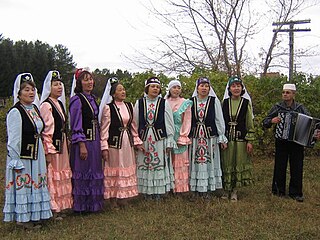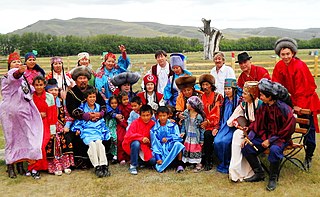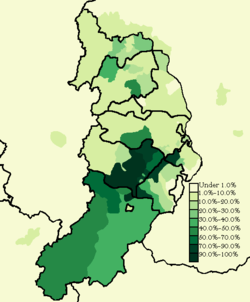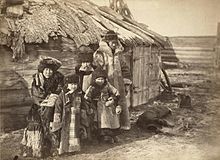
The Mongols are an East Asian ethnic group native to Mongolia, Inner Mongolia in China, and the Republic of Buryatia of the Russian Federation. The Mongols are the principal member of the large family of Mongolic peoples. The Oirats in Western Mongolia as well as the Buryats and Kalmyks of Russia are classified either as distinct ethno-linguistic groups or subgroups of Mongols.

The Kyrgyz people are a Turkic ethnic group native to Central Asia. They are primarily found in Kyrgyzstan, Uzbekistan, China, Pakistan and Afghanistan. A Kyrgyz diaspora is also found in Russia, Tajikistan, and Kazakhstan. They speak the Kyrgyz language, which is the official language of Kyrgyzstan.

Yakuts or Sakha are a Turkic ethnic group native to North Siberia, primarily the Republic of Sakha in the Russian Federation, with some extending to the Amur, Magadan, Sakhalin regions, and the Taymyr and Evenk Districts of the Krasnoyarsk region. They speak Yakut, which belongs to the Siberian branch of the Turkic languages.

The Tuvans or Tyvans are a Turkic ethnic group indigenous to Siberia who live in Russia (Tuva), Mongolia, and China. They speak Tuvan, a Siberian Turkic language. In Mongolia they are regarded as one of the Uriankhai people groups.

Siberian Tatars or Sybyrs/Sibirs are the indigenous Turkic-speaking population of the forests and steppes of Western Siberia, originating in areas stretching from somewhat east of the Ural Mountains to the Yenisey River in Russia. The Siberian Tatars call themselves Yerle Xalıq, to distinguish themselves from more recent Volga Tatar immigrants to the region.

The Chulyms, also Chulym Tatars, are a Turkic people in the Tomsk Oblast and Krasnoyarsk Krai in Russia. According to the 2020 census, there were 382 Chulyms in Russia.
The Tubalars are an ethnic subgroup of the Altaians native to the Altai Republic in Russia.

Shors or Shorians are a Turkic ethnic group native to Kemerovo Oblast of Russia. Their self designation is Шор. They were also called Kuznetskie Tatars, Kondoma Tatars, Mras-Su Tatars in some of the documents of the 17th and 18th centuries.
Fuyu Kyrgyz, also known as Manchurian Kirghiz, is a critically endangered Turkic language, and as, Gïrgïs, Kyrgysdar is an ethnonym of the Turkic unrecognized ethnic group in China. Despite the name, the Fuyu Kyrgyz language is not closely related to the Kyrgyz language, which is of Kipchak origin. The Fuyu Kyrgyz language is more similar to the Western Yugur language and the Abakan Turkic languages. The people originated in the Yenisei region of Siberia but were relocated into Dzungaria by the Dzungars.

Khakas, also known as Xakas, is a Turkic language spoken by the Khakas, who mainly live in the southwestern Siberian Republic of Khakassia, in Russia. The Khakas number 73,000, of whom 42,000 speak the Khakas language. Most Khakas speakers are bilingual in Russian.

The Altai people, also the Altaians, are a Turkic ethnic group of indigenous peoples of Siberia mainly living in the Altai Republic, Russia. Several thousand of the Altaians also live in Mongolia and China but are not officially recognized as a distinct group and listed under the name "Oirats" as a part of the Mongols, as well as in Kazakhstan where they number around 200. For alternative ethnonyms see also Tele, Black Tatar, and Oirats. During the Northern Yuan dynasty, they were ruled in the administrative area known as Telengid Province.

The Yenisei Kyrgyz, were an ancient Turkic-speaking people who dwelled along the upper Yenisei River in the southern portion of the Minusinsk Depression from the 3rd century BCE to the 13th century CE. The heart of their homeland was the forested Tannu-Ola mountain range, in modern-day Tuva, just north of Mongolia. The Sayan mountains were also included in their territory at different times. The Yenisei Kyrgyz Khaganate existed from 538 to 1219 CE; in 840, it took over the leadership of the Turkic Khaganate from the Uyghurs, expanding the state from the Yenisei territories into Central Asia and the Tarim Basin.
Leonid Pavlovich Potapov was a Soviet and Russian ethnographer specializing in the study of peoples of southern Siberia.
The Koibal are one of the subdivisions of the Khakass people of Southern Siberia. Although they speak the Turkic Khakas language, the Koibal have mixed ancestry and used to speak the Koibal dialect of the Kamas language, which is now extinct. They formed in the late 19th century from the merger of the Abugach, Baikot, Kandyk, Tarazhak, Kol and Arsh peoples. Most of these people are believed to have been of ancestry more closely related to Samoyedic peoples than to Turkics. Koibals live in the Beysky District of Khakassia.
Siberian Tatar is a Turkic language spoken in Western Siberia, Russia, primarily in the oblasts of Tyumen, Novosibirsk, Omsk but also in Tomsk and Kemerovo. According to Marcel Erdal, due to its particular characteristics, Siberian Tatar can be considered as a bridge to Siberian Turkic languages.

Content in this edit is translated from the existing Russian Wikipedia article at ru:Чебаки (крепость); see its history for attribution

The mountain range Sunduki is a natural and historical monument of local significance in the Ordzhonikidzevsky and Shirinsky districts of the Republic of Khakassia, Russia. Since June 18, 2011, the Sunduki museum has been operating on the territory of the mountain range.
Cherny Iyus is a mountain river in the northern part of Khakassia, Russia. It flows through the territories of the Shirinsky and Ordzhonikidze districts. Merging with the Bely Iyus it forms the Chulym River, the right tributary of the Ob.
The Fuyu Kyrgyz are a Turkic ethnic group who reside in Heilongjiang, China. They primarily reside in the Fuyu County. Their ethnic ties with the Kyrgyz/Kirghiz are unclear.
















